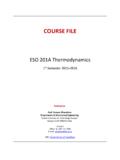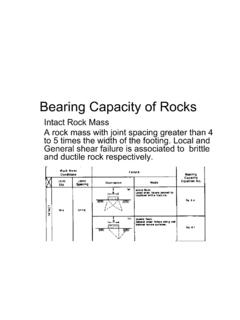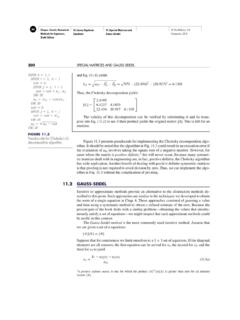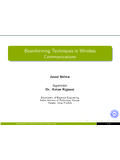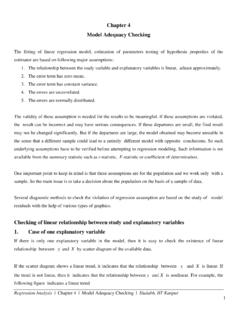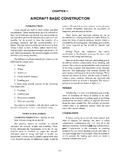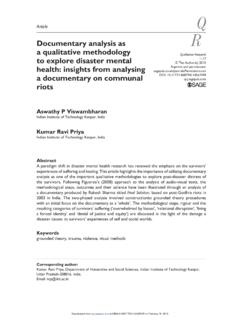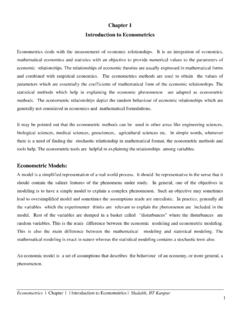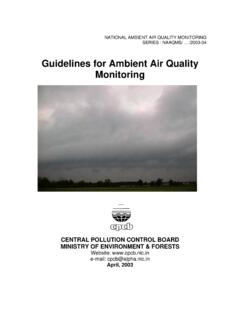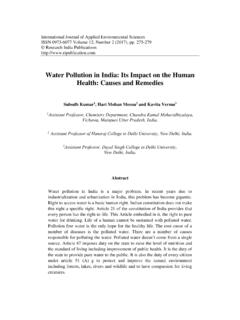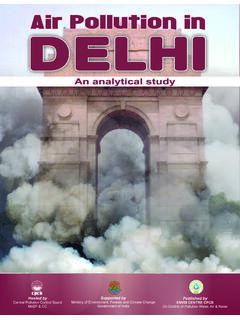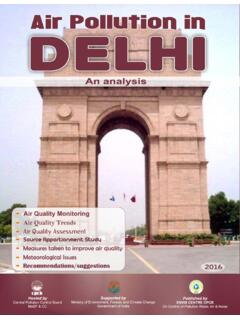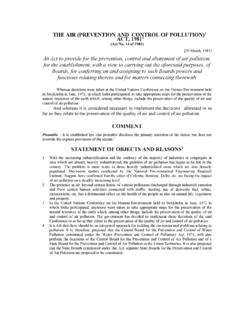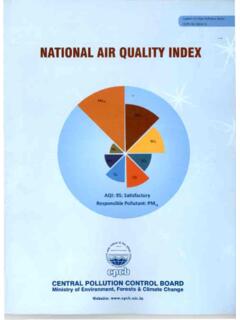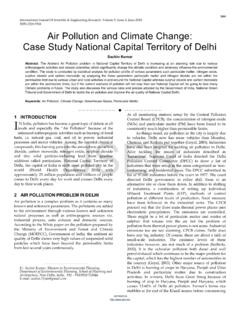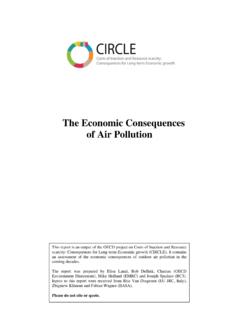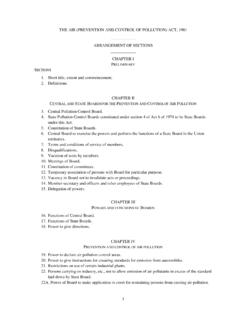Transcription of Ambient Air Quality Standards in India - Arthapedia
1 ShareFrom ArthapediaAmbient air Quality refers to the condition or Quality of air surrounding us in the outdoors. National Ambient AirQuality Standards are the Standards for Ambient air Quality set by the Central pollution Control Board( ) (CPCB) that is applicable nationwide. The CPCB has been conferred this power by the Air(Prevention and Control of pollution ) Act, Air Quality Standards in IndiaThe Air (Prevention and Control of pollution ) Act 1981 ( ) wasenacted by the Central Government with the objective of arresting the deterioration of air Quality . The Air(Prevention and Control of pollution ) Act 1981 describes the main functions of the Central pollution ControlBoard (CPCB) as follows:To advise the Central Government on any matter concerning the improvement of the Quality the air andthe prevention, control and abatement of air plan and cause to be executed a nation-wide programme for the prevention, control and abatement ofair provide technical assistance and guidance to the State pollution Control carry out and sponsor investigations and research related to prevention, control and abatement of collect, compile and publish technical and statistical data related to air pollution .
2 AndTo lay down and annul Standards for the Quality of airThe mandate provided to the CPCB under the Air (Prevention and Control of pollution ) Act empowers it to setstandards for the Quality of current National Ambient Air Quality Standards were notified on 18 November 2009( ) by the Central PollutionControl Board. Table 1: National Ambient Air Quality StandardsPollutantTime WeightedAverageConcentration in Ambient AirIndustrial, Residential,Rural and Other AreasEcologically Sensitive Area(notified by CentralGovernment)Sulphur Dioxide (SO2), g/m3 Annual*24 hours**50 8020 80 Nitrogen Dioxide (NO2), g/m3 Annual*24 hours**40 8030 80 Ambient Air Quality Standards in India - of 48/29/2016 9:01 PMParticulate Matter (size less than10 m) or PM10 g/m3 Annual*24 hours**60 10060 100 Particulate Matter (size less m) or g/m3 Annual*24 hours**40 6040 60 Ozone (O3) g/m38 hours*1 hour**100 180100 180 Lead (Pb) g/m3 Annual*24 hours** Monoxide (CO) mg/m38 hours*1 hour**02 0402 04 Ammonia (NH3) g/m3 Annual*24 hours**100 400100 400 Benzene (C6H6) g/m3 Annual*55 Benzo(a)Pyrene (BaP)-particulate phase only,ng/m3 Annual*11 Arsenic(As),ng/m3 Annual*660 Nickel (Ni),ng/m3 Annual*2020* Annual arithmetic mean of minimum 104 measurements in a year at a particular site taken twice a week 24hourly at uniform intervals.
3 ** 24 hourly or 8 hourly or 1 hourly monitored values, as applicable, shall be complied with 98% of the time,they may exceed the limits but not on two consecutive days of : National Ambient Air Quality Standards , Central pollution Control Board Notification in the Gazette ofIndia, Extraordinary, New Delhi, 18th November, 2009 Prior to the November 2009 Standards , India had set Air Quality Standards on 11 April 1994, and this was laterrevised on 14 October 1998. The 2009 Standards further lowered the maximum permissible limits for pollutantsand made the Standards uniform across the nation. Earlier, less stringent Standards were prescribed for industrialzones as compared to residential , a new National Air Quality Index (AQI) ( ) has been launched in October 2014 to disseminate informationon air Quality in an easily understandable form for the general public.
4 The measurement of air Quality is based oneight pollutants, namely, PM10, , NO2, SO2, CO, O3, NH3, and Pb for which short-term (up to 24-hourlyaveraging period) National Ambient Air Quality Standards are prescribed and the worst reading in thesepollutants represents the AQI for that StandardsThe 2005 World Health Organization's "WHO Air Quality guidelines" ( ) offer global guidance on thresholds and limits for 4 key airpollutants that pose health risks - particulate matter (PM), ozone (O3), nitrogen dioxide (NO2) and sulfurdioxide (SO2). Ambient Air Quality Standards in India - of 48/29/2016 9:01 PMGuideline values prescribed by WHO g/m3 annual mean25 g/m3 24-hour meanPM1020 g/m3 annual mean50 g/m3 24-hour meanO3100 g/m3 8-hour meanNO240 g/m3 annual mean200 g/m3 1-hour meanSO220 g/m3 24-hour mean500 g/m3 10-minute meanThe WHO Guidelines indicate that by reducing particulate matter (PM10) pollution from 70 to 20 microgramsper cubic metre ( g/m), air pollution -related deaths can be cut by around 15%[1].
5 Indian Standards are slightlyless stringent as compared to WHO guidelines. However, the world's average PM10 levels by region range from26 to 208 g/m3, with a world's average of 71 g/m3 as per WHO estimates ( ) published in 2014. Many countries have their own Ambient Air Quality Standards prescribed for their territories. The Clean Air Actin the US requires the Environment Protection Agency (EPA) to set National Ambient Air Quality Standards (NAAQS). Two types of Ambient Air Quality Standards are identified in the Clean Air Act: Primary standardsprovide public health protection, including protecting the health of "sensitive" populations such as asthmatics,children, and the elderly and Secondary Standards provide public welfare protection, including protectionagainst decreased visibility and damage to animals, crops, vegetation, and buildings.
6 [2] NAAQS has been set forsix pollutants in the US, namely, carbon monoxide, lead, nitrogen dioxide, ozone, particle pollution and sulphurdioxide. The values for these pollutants may be seen here ( ) .The European Union has also developed legislations on air Quality Standards . The pollutants for which thestandards are specified are: , sulphur dioxide (SO2), nitrogen dioxide (NO2), PM10, lead (Pb), carbonmonoxide (CO), Benzene, Ozone, Arsenic (As), Cadmium (Cd), Nickel (Ni), Polyclic AromaticHydrocarbons.[3] Details may be seen here ( ) .1. Ambient (outdoor air pollution ) in both cities and rural areas was estimated to cause million prematuredeaths worldwide in 2012 according to Air Quality Standards in India - of 48/29/2016 9:01 PMNational Air Quality Index ( )National Ambient Air Quality Standards , Central pollution Control Board Notification( ) in the Gazette of India ,Extraordinary, New Delhi, 18th November, 2009 Comparative study of European and US air Quality Standards ( )WHO Factsheet on Ambient air Quality as updated in March 2014 ( )Mr.
7 M Rahul (IES 2013) ( )Email- from " "Category: ConceptsThis page was first created on 10 August 2015, at 07:34 and last modified on 10 August 2015, at 16 page has been accessed 10,871 Air Quality Standards in India - of 48/29/2016 9:01 PM
